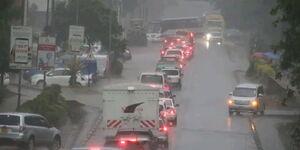The Kenya Wildlife Service (KWS) has responded to a viral video showing a lion crossing the Nairobi-Mombasa Highway.
A section of Kenyans Friday, March 3, raised concerns over the video which was shared on social media platforms as they questioned safety measures taken to protect road users and the lions.
Speaking to Kenyans.co.ke, KWS Senior Assistant Director in charge of the Tsavo Conservation Area, Captain Kenneth Ochieng, downplayed the outrage noting that the lions were in their natural habitat and there was no cause for alarm.
He noted that it is normal for the lions to cross the road from one end of the Tsavo National Park to the other, especially the area through which the Nairobi-Mombasa Highway traverses Tsavo West National Park.
The Assistant Director dispelled safety fears raised by a section of Kenyans - stating that the motorists are usually in their vehicles and not walking hence no direct contact with the animals.
“The video was captured by motorists as the lion crossed the road to the other side That is normal, the lions are in their habitat as the region is classified as part of the Tsavo Man-Eaters Area," the KWS official told Kenyans.co.ke.
While reacting to the video, a section of Kenyans questioned the rate of human encroachment on wildlife areas, especially in the wake of increased infrastructural projects eating up national parks lands.
"We invaded and continue invading the natural habitat for world life including their migration paths. It, therefore, follows that scenes like these are unavoidable," read a comment from a Twitter user.
In addition, some of the comments posited that the presence of wild animals along the Highway was due to the ongoing drought- arguing that the wildlife is forced to migrate in search of pasture and food.
The Tsavo Conservation Area- which comprises the Tsavo East and Tsavo West National Parks is managed by KWS and forms part of the zone categorized as a protected area.
KWS regulations advise tourists or motorists to “stay in their vehicle" in such areas, except at "designated picnic or walking areas.”
The Tsavo lions are, however, not the first case of human-wildlife conflict in Kenya. Similar concerns about conflicts between human activities and animals were raised during the construction of the Standard Gauge Railway after the plans showed that the multi-billion project would traverse through Tsavo National Park.












